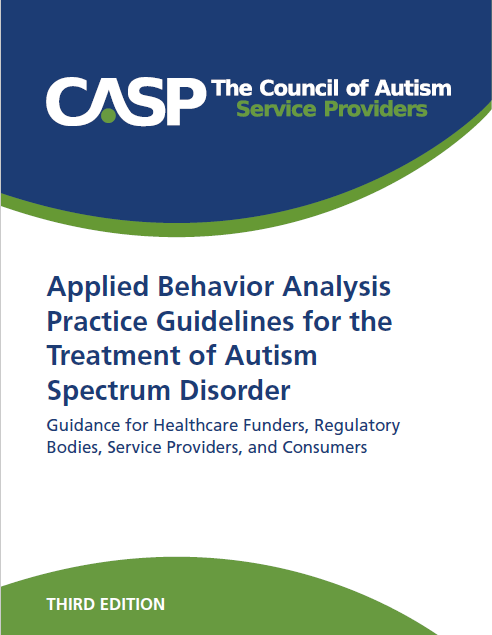ABA Practice Guidelines (Version 3.0)
Executive Summary
The purpose of CASP's Applied Behavior Analysis Practice Guidelines for the Treatment of Autism Spectrum Disorder (the "ABA Practice Guidelines") is to inform decision-making regarding the use of ABA as a medically necessary, efficacious, and cost-effective treatment to develop, maintain, or restore, to the maximum practicable extent, the functioning of individuals with autism spectrum disorder (ASD).
These practice guidelines are based on the best available scientific evidence and expert clinical opinion regarding the use of ABA as a behavioral health treatment for people diagnosed with ASD. The guidelines are intended to provide a concise, user-friendly introduction to the delivery of ABA services for ASD and to reflect consensus standards for the effective practice of these services. They are written for healthcare funders, agents of government health programs and private health insurance plans, regulatory bodies, consumers, and ABA practitioners and employers.
These practice guidelines provide information about standards of care in ABA that should be used in planning, implementing, and evaluating assessment and treatment services. As a behavioral health treatment, ABA includes many distinctive clinical and delivery components. It is important for all stakeholders, including those receiving and providing services, coordinating care, administering funding, or building provider networks, to understand the essential elements of ABA.
Download the CASP ABA Practice Guidelines
The CASP ABA Practice Guidelines are intended for use by a variety of stakeholders, e.g., healthcare funders, regulatory bodies, service providers, and consumers. A licensing agreement must be completed prior to accessing the ABA Practice Guidelines for either educational/non-commercial or commercial use.
Educational/Non-Commercial Use
Access to the CASP ABA Practice Guidelines is provided free of charge for individuals and organizations using it for educational, research, or general reference purposes. This includes:
- Academic institutions, educators, and students
- Clinicians and practitioners using it for professional development or clinical guidance
- Policymakers using it to inform policy decisions
- Advocacy groups and non-profit organizations referencing it for public awareness or policy advocacy
- Other entities or individuals not meeting the criteria for commercial use as detailed below.
To access the CASP ABA Practice Guidelines for educational/non-commercial use, please complete this limited license agreement. Upon acceptance of the terms, you will be emailed a digital copy.
Citing the CASP ABA Practice Guidelines
When referencing the CASP ABA Practice Guidelines, please use this citation:
Council of Autism Service Providers [CASP] (2024). Applied behavior analysis practice guidelines for the treatment of Autism Spectrum Disorder: Guidance for healthcare funders, regulatory bodies, service providers, and consumers [Clinical practice guidelines]. https://www.
Commercial Use
Examples of commercial use of the CASP ABA Practice Guidelines include use by healthcare funders (e.g., insurance companies, managed care organizations, third-party administrators) to:
- Make medical necessity determinations
- Conduct utilization management
If a healthcare funder uses the CASP ABA Practice Guidelines to inform decisions affecting the approval, denial, or coverage of services, this constitutes commercial use.
Access to the CASP ABA Practice Guidelines for commercial purposes requires
- acceptance of Terms and Conditions for Health Funders,
- completion of CASP-sponsored training on the use of the ABA Practice Guidelines by all authorized users, and
- payment of the associated licensing and training fees.
To request additional information on commercial access to the CASP ABA Practice Guidelines, please email info@casproviders.org.
The ASD Practice Guidelines were originally published by the Behavior Analyst Certification Board. In March 2020, the Guidelines were transferred to CASP. The 3rd edition of the ASD Practice Guidelines was released on April 29, 2024.



